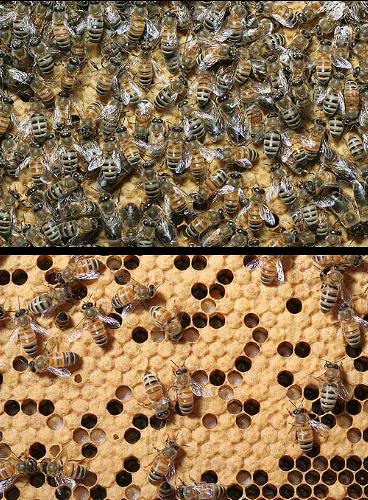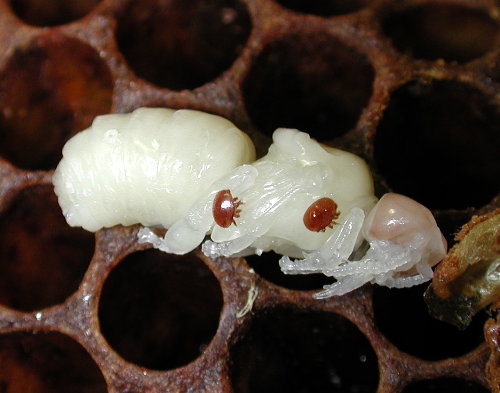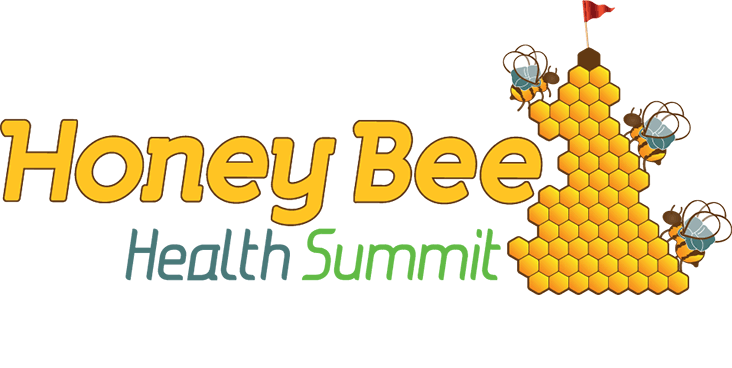In June of this year, Monsanto, the company so many love to hate, sponsored the Honey Bee Health Summit at its St. Louis, Missouri, Research Center. The summit’s goal was to create an informed exchange among academics, NGOs, government and private sector participants to find a solution to improving the health of honey bee colonies.
In 2011 Monsanto had acquired Beeologics, an Israeli company focused on developing biological tools for protecting bee health. Monsanto saw this acquisition as a means by which it could contribute to speeding up Beeologics research on Colony Collapse Disorder (CCD) and its root causes.
If you are not familiar with CCD, as seen in the before and after pictures seen directly above, it is a phenomena first reported in 2006. It has crippled millions of beehives around the globe with over one-third of colonies in decline. Its cause has been attributed to multiple factors including:
- parasitic mites;
- viruses;
- insecticides and herbicides;
- the loss of wildflower domains and natural occurring weeds because of monoculture farming practices leading to bee nutritional deficits;
- the decline in wild honey bee populations reducing the genetic pool and directly attributed to the previous point.
Some of the blame is attributed to bee keepers themselves, the apiarists who manage the millions of colonies that are part of the domestic industry. They have been accused of creating a restricted genetic pool of queen bees bred for docility in offspring and focused on high-levels of honey production.
But without knowing which of the many factors is key to CCD, a company like Beeologics has its work cut out for it. The line of research the company has chosen focuses on Israeli acute paralysis virus, or IAPV which has been correlated to CCD in 83% of infected colonies and is completely absent in healthy honey bees. IAPV is associated with the Varroa mite, which feeds on honey bee larvae and pupae as seen below. The mite is believed by many who study CCD to be a key in reversing the disorder.
Beeologics chose to develop targeted RNA interference (RNAi) technology that mimics how RNA works with cellular DNA in plants and animals. This genetic manipulation does no harm to the bees who in larval stage ingest the RNAi through a sugar water solution placed in the comb before the queen lays eggs. The RNAi technology is called Remebee (TM) and although it does no harm to the bee larvae, when consumed by a Varroa mite it sets off a self-destruct DNA trigger. The RNAi technology only works when it is aligned to match the targeted RNA, and since scientists have sequenced the genomes of the honey bee and Varroa mite they have identified exactly where they can apply genetic interference to kill the latter without impacting the former.
For Monsanto, acquiring Beeologics is all about speeding RNAi research so that it can be applied not just to helping honey bees but also agricultural crops which may become resistant to existing herbicides and pesticides. Many who see Monsanto and its glyphosate-based pesticides as the real cause of CCD must be somewhat conflicted by the image of the company as a potential honey bee lifesaver. But this research into RNAi has huge implications not just in agriculture but in combating human diseases that alter genes or have genetic roots. And if successful may finally reverse the worldwide phenomenon of CCD.



















Monsanto as enviro hero is hard to imagine but if the research can reverse trend more power to it.
On a related note a large bee kill was observed very recently in Elmwood, Ontario.
http://www.thepost.on.ca/2013/06/19/bees-dying-by-the-millions
In North America there has been a better than 30% decline in the honey bee population. I know it has been obvious to me as a gardener with the disappearance of honey bees in my flowering plants. What I see now are bumblebees, stingless bees, hornets and wasps.
[…] Apparent “disappearance” of the bees from their hive. Source […]
[…] [10] https://www.21stcentech.com/agriculture-update-beeologics-save-honey-bees-colony-collapse-disorder/ […]